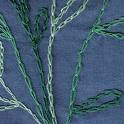I did not really mind wasting the period by making pencil-holders by wrapping colourful paper around old talcum powder tins, and other fanciful and useless things like making prints with cut slices of ladies’ fingers (the vegetable) and onion-halves.
What irked and bothered me was the compulsory sewing projects we girls had to undertake. I remember we had a lady teacher teaching us the subject for a few years, who would insist on all the girls sitting and learning various kinds of stitches. The boys, lucky idiots, were spirited away to some unspecified location, where they made unrecognizable clay models and wood-carvings.



The stem stitch and chain stitch were all right, I suppose, if you overlooked the variously sized links of the chain, or bits of the stem. The criss-cross herringbone always made me cross, although I enjoyed the neatly laid-out patterns of the cross stitch where I had only to follow the design laid out on the graph and where the stitches would automatically be of the same size, because the cloth itself was woven like a grid.

But I was completely flummoxed by the really intricate stuff like the neat hem stitches, buttonhole-stitches (my holes looked as if they had been forced by a particularly belligerent big button), French knots and the tiny satin stitches. I was really really bad at the fine art of needle craft, which was fairly surprising because both Maa (mother) and Didia (my cousin) spent long hours discussing patterns and colours and creating delicate gossamer embroidery on many of our dresses. Unfortunately, my admiration did not progress to emulation, and I remained handicapped at handicraft.

And so, I breathed a huge sigh of relief when the stern sewing mistress left our school and was replaced by the affable Maity Sir, who taught both Bengali and SUPW. I put away the handkerchiefs with the uneven half-finished hems, and the round wooden embroidery frame and VIBGYOR silk threads. And happily spent the rest of my SUPW periods making unproductive and silly stuff like soap-gardens (where you had to stick paper flowers and leaves on wires into the soap and make a fancy fence-border with pins and garish plastic ribbons). Horribly tacky stuff, but easier to tackle than sewing.
DO SEW A MEMORY TO THIS POST.









